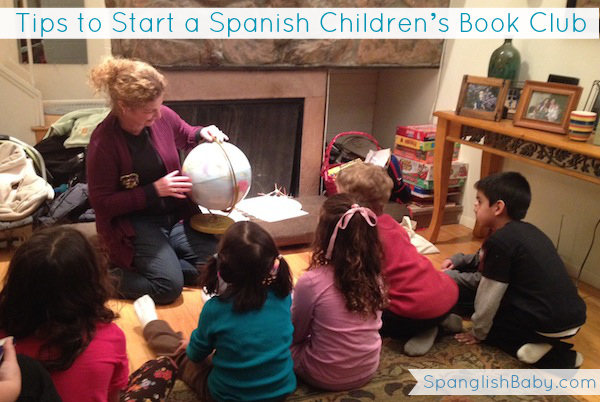
For almost two years now, I’ve been taking Vanessa to a monthly Spanish children’s book club started by a bilingual mom I’m lucky to call my friend. While I’ll never get tired of raving about the benefits of joining a Spanish-speaking playgroup, once kids get a bit older and start school, it’s not as easy to participate in weekly meetups for the kids to be immersed in Spanish. Enter the idea of a Spanish children’s book club.
If your kids are already in school and you want a more structured way of exposing them to literacy skills in Spanish, a book club is the way to go. But how do you go about doing something like that? In my case, I got really lucky because my friend Sisi — who worked 16 years as a bilingual kindergarten teacher and is one of the original members of our Spanish-speaking playgroup — was the one who came up with the idea and took the lead. Truth is, though, that you don’t have to be a teacher to do something similar.
Here’s a look at how our book club is structured: Sisi starts by reading the book and interacting with the kids at all times by asking pertinent questions and making sure everyone understands new vocabulary. Once she’s done with the book, she goes through a series of reading comprehension questions regarding the characters, the setting, the problem, the solution, etc. to make sure every kid got the story. Then, there’s always some kind of activity or craft related to the theme of the book. Sometimes it involves food and the kids love that. Before we’re done, all kids get a copy of the book and a stamp in their “passport” so they can keep track of all the books they’ve read.
I highly recommend starting something similar for your bilingual kids and so I wanted to share some ideas on how to get started:
1. If you already belong to a Spanish-speaking playgroup, talk to the other moms to see if maybe one of them is interested and has the abilities to lead a book club for children. Maybe you can help organize all the little details, but someone else can be the “teacher.”
2. Keep in mind that for a Spanish book club to be successful it should be for a smaller group of kids who are a bit older and are already fluent in Spanish.
3. On that note, choose a book that you feel all kids will understand, but that hopefully will teach them new vocabulary words. The theme of the book should lend itself to fun activities and a lively discussion.
4. The club shouldn’t last more than 1 1/2 hours, including snack time and an activity that includes movement.
5. You can alternate who’ll be hosting the club every month to make it easier on everyone.
6. A fun way for kids to keep track of the books they’ve read is through a passport. Kids really enjoy the challenge of filling it up with stamps.
¡Buena suerte!


These are wonderful suggestions. I was wondering if you have any ideas about starting a Spanish book club for children who are not yet bilingual. Would you recommend dual language books or books that are solely in Spanish. I’m looking for ways to bring Spanish to my small town. ¡Gracias!
Roxana, gracias por compartir tu experiencia, mi propósito este verano es enseñar más español a mis dos hijos, y creo que una buena idea sería incluir dos de sus amigos en el club, tal vez así ellos se sientan mucho más motivados a participar y a aprender nuestro idioma. Te contare en un futuro como me fue.